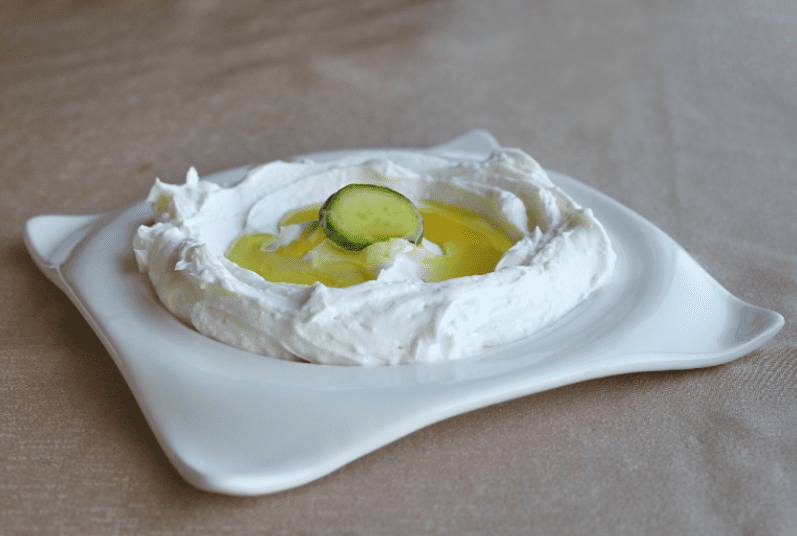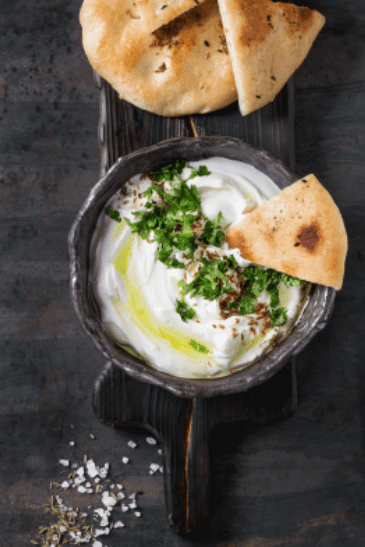
What is Labneh? It is strained yogurt that is closer to cream cheese than pudding in texture. Because some of the whey has already been filtered out, most labneh recipes call for Greek yogurt.
Because some dubious “Greek-style” yogurts thicken unnaturally rather than naturally, read the label and choose the ones that don’t have any thickeners (such as gelatin or guar gum).
Any yogurt, from any mammal, can be used to make labneh. For those of you who are not in the mood to taste your meal, it can be any fat level, even fat-free.
Finally, we’ll go over how to prepare labneh. It’s so simple that even I, an Irish American, or a moderately bright chimp, could accomplish it, and I’d love to see it.
Labneh is made up of only two ingredients: yogurt and salt. A colander or sieve, a bowl, and some cheesecloth are all you’ll need (or a clean dish towel).
Here’s How To Do It
1. Line your colander with several layers of cheesecloth, leaving the ends flapping over the edge.
2. Stir the salt into the yogurt (1 teaspoon per quart), then scrape it onto the cheesecloth.
3. Gather the cheesecloth’s corners and knot or twist them together to produce a convenient yogurt sack, similar to what Cow Santa might carry. Squeeze the pouch gently to release some of the whey, then return it to the colander within the bowl and refrigerate the whole thing.
4. Remove the bowl from the fridge after a day or two – the longer you keep it, the firmer your labneh will become. Scrape the labneh into a bowl after giving the sack one last gentle press.
That is the answer to What Is Labneh. You have labneh now.
Here you are: “Great. I now have labneh. And?”
Well, you can eat it right away, or you can add some flavoring components of your choice:
parsley, mint, garlic, or the spice mix known as za’atar are all common Middle Eastern flavors.
But, since this is Anytown, United States of America, you may add whatever you want:
herbs de Provence, ginger, chipotle, Sriracha. In terms of its propensity to serve as a culinary canvas, think of it like cream cheese. Honey, agave, or maple syrup could be used to sweeten it.
Whatever you do, remember to keep the whey. It’s great in smoothies, batters, soups, and sauces.
Imagine labneh’s cousins, hummus and baba ganoush, then schmear it on a platter into a round of beautiful concavity, like an inverted Frisbee, to serve it fresh.

Drizzle extra-virgin olive oil liberally over everything and top with any of the herbs and spices listed above, tomatoes and olives, or anything else that makes you smack your lips like a weasel watching “Watership Down.”
If you’re too hungry for gorgeous things, smear some labneh on a bagel for the love of God. It can also be used in the same way as any other condiment: It’s delicious on burgers, sandwiches, and wraps.
Scoop a teaspoon or two into a dish of black, crimson, or white dal or beans. To thicken and enrich a vinaigrette or sauce, whisk it in.
Any leftover labneh can be stored in the fridge in an airtight jar for up to a week.
Alternatively, consider this:
Soak your hands with water or olive oil, and shape the labneh into walnut-sized or sauropod balls.
Fill a jar halfway with extra-virgin olive oil and soak the balls thoroughly. They’ll easily survive a couple of months in the freezer.
Oh, and if you do that, try rolling the balls in something attractive and flavorful, like paprika or za’atar, after they’ve been formed but before they’ve been submerged.
Labneh Recipe
Prep: 5 minutes
Drain: 24 hours to 3 days
Makes: 4 to 6 plates
Get yogurt with no artificial additives or thickeners.
¼ tea-spoon of salt
2 cups of traditional Greek yogurt
Extra-virgin olive oil, as desired.
1. Line a colander or mesh colander with a couple of sheets of cheesecloth; set it over a pot large enough to hold it stable.
2. Whip salt into the yogurt and scrape straight onto the cheesecloth. Take the cheesecloth edges simultaneously and twist or knot them together.
3. Set the pot with the colander with the cheesecloth with the yogurt in the fridge for 24 to 72 hours. (The longer the drain time, the thicker and drier the labneh will be.)
4. After straining, compress the bag lightly to discharge any extra liquid. Serve labneh promptly (see below) or store it cooled in an airtight vessel for up to 3 or 4 days.
As an alternative, roll labneh into 2- to 3-inch balls and place them on a foil pan. Top with a clean towel and refrigerate overnight to firm up a bit.
Refrigerate the labneh balls after they have firmed up, fully soaked in extra-virgin olive oil in an airtight container. They’ll last for two months.
Nutrition science per serving (for 6 plates): 114 cal, 3 g fat, 2 g sat fat, 8 mg cholesterol, 6 g carbs, 6 g sugar, 15 g protein, 146 mg sodium, 0 g fiber
Serve it up!
Labneh can be enjoyed plain with pita, bagels, or chips, or it can be used to make sandwiches and burgers or blended into soups and stews like sour cream.
Spices and extra-virgin olive oil can be blended in to taste or sprinkled on top of fresh labneh. Alternatively, the labneh balls can be rolled in these ingredients before being preserved in oil.
Spread fresh labneh on a platter in a thick circle.
Fresh minced herbs, dried or fresh mint, sumac, za’atar, smoked paprika, black pepper, crushed pistachios, minced garlic, or any other flavored component you want can be sprinkled on top.
Serve immediately with a generous drizzle of extra-virgin olive oil.
Here is Video To Help You Make Labneh
It is with Italian Hints, but, it is easy to follow.






















